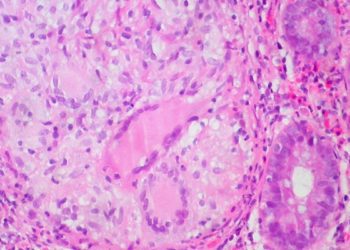Dolutegravir associated with improved viral suppression in HIV-positive pregnant patients
1. Dolutegravir is associated with greater viral suppression at birth for human immunodeficiency virus (HIV)-positive pregnant patients compared to standard treatment regimens.
2. There were no clear differences in adverse birth outcomes between patients on dolutegravir-based therapies compared to those who were not.
Evidence Rating Level: 1 (Excellent)
Study Rundown: HIV-positive pregnant patients require antiretroviral therapy (ART) to prevent pregnancy complications. The data on the effectiveness and safety of dolutegravir-based therapies have not been sufficient in the current literature. Participants who received dolutegravir had a higher percentage of pregnancies in which viral suppression was present compared to other types of ART. Of pregnancies where ART was started during pregnancy, dolutegravir had greater rates of viral suppression at delivery than those on other ART. The adverse outcomes of being born premature, having low birth weight, and being small for gestational age were not significantly different between groups on dolutegravir versus other forms of ART. No neonatal deaths occurred in any of the groups. Four instances of perinatal HIV transmission occurred, none of which were in participants taking dolutegravir. A strength of this study is the large and diverse population size from multiple countries and of various health statuses. A limitation of the study was that important predictors of adverse birth outcomes were not reported, such as parity, previous preterm birth, and pre-pregnancy body mass index. This study contributes important information on the effectiveness of dolutegravir specifically for HIV-positive pregnant patients.
Click to read the study in NEJM
In-Depth [prospective cohort]: The present study aimed to delineate the efficacy of dolutegravir as compared to other ARTs for HIV-positive pregnant patients. The study included 120 participants on dolutegravir, 464 on atazanavir-ritonavir, 185 on oral rilpivirine, 86 on raltegravir, and 159 on elvitegravir-cobicistat. A total of 51% of participants received ART before conception. Most pregnancies were in non-Hispanic Black participants, with a median age of conception of 29 years. Comparisons between dolutegravir and other ART regimens were adjusted for age of conception, the participant reported race and ethnic group, level of educational attainment, the timing of maternal HIV infection diagnosis, trimester at the first prenatal care visit, preconception or postconception use of ART, alcohol use during pregnancy, and any sexually transmitted infections during pregnancy. For those who received dolutegravir, 96.7% had viral suppression at delivery compared to 84% for atazanavir-ritonavir, 90.1% in darunavir-ritonavir, 89.2% in raltegravir, and 89.8% for elvitegravir-cobicistat. When compared to other forms of ART, dolutegravir had greater rates of viral suppression at delivery. Specifically, compared to atazanavir-ritonavir, dolutegravir had an adjusted risk difference of -13% (95% Confidence Interval, -17.0 to -6.1). For participants on dolutegravir or who received dolutegravir in the first trimester, three of 95 infants were born with major congenital anomalies. No clear differences were observed across all ART regimens and dolutegravir regarding other adverse birth outcomes. This study provides evidence for the effectiveness and safety of dolutegravir in HIV-positive pregnant patients.
Image: PD
©2022 2 Minute Medicine, Inc. All rights reserved. No works may be reproduced without expressed written consent from 2 Minute Medicine, Inc. Inquire about licensing here. No article should be construed as medical advice and is not intended as such by the authors or by 2 Minute Medicine, Inc.







